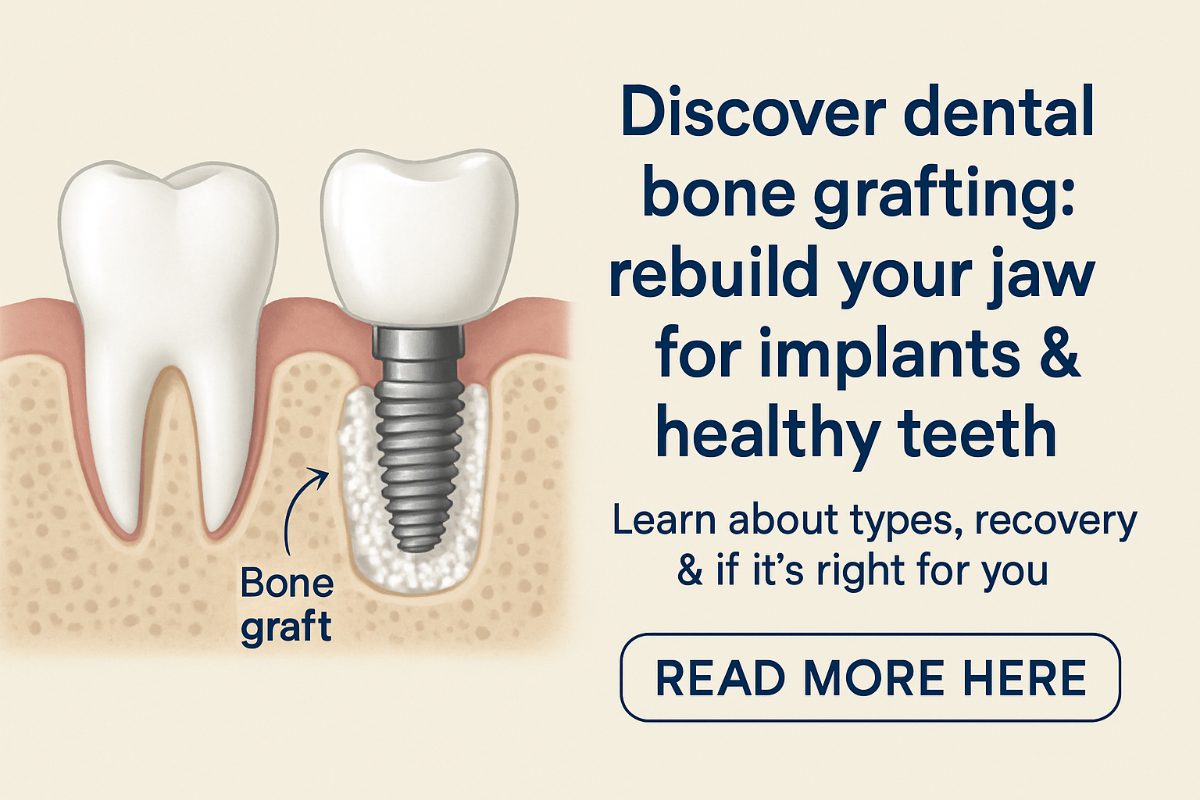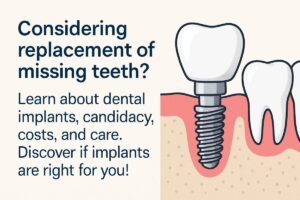Dental bone grafting is a procedure that rebuilds lost jawbone so your teeth or implants have a solid foundation. If you’ve been told you don’t have enough bone for an implant, have loose or drifting teeth, or struggle with denture fit, this article explains what dental bone grafting is, who might need it, the main types, how it works, recovery, risks, and next steps.
What Is Dental Bone Grafting?
Dental bone grafting is a surgical method to replace or add bone to the jaw. The main goals are to restore bone volume, support dental implants, and preserve facial structure. Healthy bone keeps teeth stable and supports gums; without it, teeth can shift, dentures can fail, and implants may not integrate properly.
Who Needs Dental Bone Grafting?
Signs that you might need a graft
Long-term missing teeth, loose or drifting teeth, visible gum recession with exposed roots, difficulty keeping dentures in place, or a history of failed extractions are common signs. Your dentist may also detect low bone volume on X-rays or 3D scans and recommend grafting before implant work.
Common reasons for bone loss
Bone loss often results from untreated gum disease (periodontitis), trauma, chronic infection around a tooth, or long-term tooth loss where the bone slowly resorbs. Some people have congenital low bone volume or medical conditions that affect bone health.
Types Of Dental Bone Grafting
Autograft (your own bone)
Autografts use bone taken from your body, often from the jaw, hip, or chin. They are highly reliable because they contain living cells that help bone grow, but they require a second surgical site and longer recovery.
Allograft & Xenograft
Allografts come from human donors and xenografts from animals (usually bovine). These materials are processed and sterilized, so there’s no second surgical site. They’re widely used and work well for many cases, though they rely on your body to gradually replace the graft.
Synthetic grafts & growth factors
Synthetic materials and biologic growth factors (like BMPs or platelet-rich preparations) can encourage bone formation without donor tissue. These options reduce donor-site issues and can speed healing when used appropriately.
How Dental Bone Grafting Works
Treatment starts with a consult and imaging—often 3D CT scans—to map the jaw and plan precisely. During surgery, the graft material is placed where bone is needed and covered with a membrane or sutures. Healing follows for weeks to months while new bone forms. If planned for implants, placement occurs after the graft integrates or sometimes at the same visit when circumstances allow.
Recovery, Timeline, And What To Expect
Healing can take from a few weeks to several months depending on graft size and type. Expect mild swelling, some discomfort, and a soft-food diet initially. Pain can be managed with prescribed or over-the-counter medications. Keep the area clean and report heavy bleeding, severe pain, fever, or unusual drainage to your dentist.
Risks, Costs, And Alternatives To Dental Bone Grafting
Possible complications include infection, swelling, graft failure, or delayed healing. Costs vary by graft type, complexity, and whether additional procedures (like sinus lifts) are needed. Alternatives include zygomatic or pterygoid implants for severe upper-jaw loss, or ridge-sparing and short implants in specific cases—your dentist will discuss what fits your anatomy and budget.
Why Experience And Technology Matter For Dental Bone Grafting
Experienced clinicians and advanced imaging improve predictability and safety. At Eggleston Dental Care, implant expertise, 3D imaging, nano-ceramic temporaries, and sedation options are used to plan and execute grafting with precise results and patient comfort. Skilled teams reduce complications and help deliver long-term function and aesthetics.
How To Find Out If You Need Dental Bone Grafting
Schedule a consult with 3D imaging to evaluate your jaw. Bring any prior dental records or X-rays and be ready to ask about graft materials, timeline to implants, risks, and financing. If you’re near Turlock, CA, talk to a provider about dental bone grafting in Turlock, CA for a tailored plan. Contact Eggleston Dental Care to book an implant planning consult and 3D assessment.






